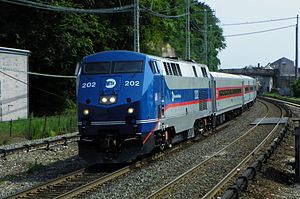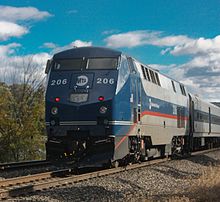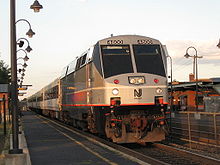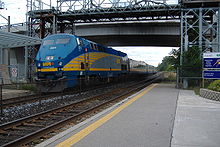- GE Genesis
-
GE Genesis 
Metro-North GE Genesis P32AC-DM #202 in new paint scheme Power type Diesel-electric Builder GE Transportation Systems Model P40DC, P32AC-DM, P42DC Build date 1992–2001 AAR wheel arr. B-B UIC classification Bo′Bo′ Gauge 4 ft 8 1⁄2 in (1,435 mm) Trucks Krupp-MaK high-speed bolsterless Wheel diameter 40 in (1,016 mm) Wheelbase 43 ft 2.5 in (13.170 m) (between truck centers) Length 69 ft 0 in (21.03 m) Width 10 ft 0 in (3.05 m) Height 14 ft 4 in (4.37 m) Locomotive weight P40, P42: 268,240 lb (121.7 tonnes)
P32: 274,400 lb (124.5 tonnes)Fuel type 2,200 US gal (8,300 l; 1,800 imp gal) Prime mover GE 7FDL16 (P40DC, P42DC), GE 7FDL12 (P32AC-DM) Engine type 45° V16, four stroke cycle (P40DC, P42DC), 45° V12, four stroke cycle (P32AC-DM) Aspiration Turbocharged Top speed 103 mph (166 km/h) (original P40DC), 110 mph (177 km/h) (P42DC, P32AC-DM, upgraded P40DC), 60 mph (96.6 km/h) (in electric mode P32AC-DM only)[1] Career Amtrak, Metro-North Railroad, Via Rail Canada, New Jersey Transit Number Amtrak: 1-207 (P42DC), 700-717 (P32AC-DM), 800-844 (P40DC)
(half in storage)
Metro-North: 201-231 (P32AC-DM only)
VIA Rail Canada: 900-920 (P42DC only)
New Jersey Transit: 4800-4803 (P40DC only)
(acquired from Amtrak 8xx batch)GE Genesis (officially trademarked GENESIS[2] ) is a series of passenger locomotives produced by GE Transportation Systems, a subsidiary of General Electric. Between the period of 1992 and 2001, 332 of these locomotives were built for Amtrak, Via Rail, and Metro-North.
The Genesis series of locomotives was designed by General Electric in response to a specification published by Amtrak and ultimately selected over a competing design presented by GM EMD. The Genesis series are unique among current North American diesel-electric locomotives because of their low height. This height restriction allowed the locomotive to travel easily through low-profile tunnels in the Northeast Corridor. The Genesis series is lower than even the previous-generation F40PH by 14 inches (35.6 cm), and is the only Amtrak diesel locomotive that meets the clearance requirements on every Amtrak route.
Contents
Technical design
The General Electric Genesis series is unique among recently manufactured North American passenger locomotives in that it uses a single, monocoque carbody design, thus making it lighter, more aerodynamic,[3] and more fuel efficient than its predecessors (F40PH, F59PH, P30CH, P32-BWH). However, this makes it more costly and time-consuming to maintain, causing Amtrak to install bolt-on nose cones, for easy replacement in the event of grade-crossing collision. As an example of the improvements over the predecessor locomotives, the Genesis uses 22% less fuel than the F40PH while producing 25% more horsepower.[4] In addition, all Genesis locomotives have four-stroke engines instead of the two-stroke engines previously used in EMD counterparts.
The Genesis unit is a fully computerized locomotive which automatically controls all on-board functions, thus producing high reliability while keeping the maintenance requirements low. For example, the Genesis' computers will automatically reduce the power plant's output in the event that the locomotive is overheating, or suffering from low oil pressure, low water pressure, or reduced airflow into the intakes, thus making it still operable.[4]
All Genesis units can provide head-end power (HEP) to the train with capacity of 800 kilowatts output, drawn from an alternator or inverter powered by the main engine. The P40DC and P42DC power plants are speed locked to 900 rpm when operating in HEP mode, with head-end power supplied directly by the alternator. The P32AC-DM powerplant does not have to be locked at a certain rpm because it utilizes an HEP inverter, which allows the prime mover to run at 900 rpm when providing both traction power and HEP, and to idle at 620 rpm (or notch three) while still providing HEP for lighting and air-conditioning when not providing traction power.
The trucks of Genesis locomotives were made by Krupp Verkehrstechnik, which has since been absorbed by Siemens Mobility; the trucks on the newest Genesis locomotives carry the Siemens name.
Models
There are three models of Genesis units in operation today: the P32AC-DM, P40DC, and P42DC. They were built between 1992 and 2001.
P40DC
The P40DC, or Dash 8-40BP (originally known as the AMD-103 or Amtrak Monocoque Diesel - 103MPH) was the first model in the Genesis series. The locomotive operates in a diesel-electric configuration that uses DC to power the traction motors, producing 4,000 horsepower (2,980 kW) output. When in HEP mode, power output to the traction motors is 3,650 hp (2,720 kW). The P40DC is geared for a top speed of 103 miles per hour (166 km/h). The P40DC was succeeded in 1997 by the P42DC.
A feature unique to the P40DC Genesis locomotive is a hostler stand at the rear of the locomotive providing increased visibility and reversing capabilities to the engineer while conducting reverse operations. When a unit is in operation from this stand it is limited to 10 mph (16 km/h) and a dead man's switch protects against movement without an operator being present.[4]
The P40DC and P42DC allowed Amtrak to operate heavy long-distance trains with fewer locomotives compared to the older EMD F40PH locomotives. Two P40DCs could do the same work as three F40PHs. Additional deliveries of the P42DC ended up replacing the P40DCs. Four were sold to New Jersey Transit in 2007, and eight to the Connecticut DOT for Shore Line East. Three of the locomotives (807 and 829 in the Bourbonnais train wreck and 819 in the Big Bayou Canot wreck) were wrecked and have been partially broken up, and the other 30 remained out of service in dead storage for many years.[5]
Upgraded and "Stimulus" P40DCs
By 2007, New Jersey Transit had upgraded their P40DC locomotives with updated prime movers to match the 4,250 horsepower (3,170 kW) of the successor P42DC.[6] This was done by readjusting the position of the lay shafts within the prime mover.
Amtrak is returning fifteen of their P40DC units to service as part of a project funded through the American Recovery and Reinvestment Act of 2009.[7] The first of the units were returned to service in March 2010 after being overhauled at the company's shops in Beech Grove, Indiana. The locomotives were upgraded like NJT's units had been a few years before to have 4,250 hp (3,170 kW) and match the P42DC's top speed of 110 mph (177 km/h). They also received updated cab signaling systems. The upgraded locomotives still have mechanical air brakes, which makes them most suitable for trains that only require a single locomotive. This differs from the electronic air brakes on the P42DC and P32AC-DM.[8]
P42DC
Via Rail P42DC #901 leaving Toronto on its way to Montreal.
The successor to the P40DC, this unit was first produced in 1997. It has an output of 4,250 horsepower (3,170 kW), or 3,875 horsepower (2,890 kW) when running in HEP mode (900 rpm). The P42 has a top speed of 110 mph (177 km/h), while Via Rail Canada only permits these units to travel at a top speed of 100 mph (160.9 km/h).[9] Tractive effort is rated at 394 kN (88,570 lbf) of starting effort and 267 kN (60,000 lbf) of continuous effort.
This unit is used primarily on most of Amtrak's long haul and high speed service outside the Northeast Corridor as well as high speed service on Via Rail's Quebec City-Windsor rail corridor when it replaced the LRC locomotives in 2001.
General Specifications
- Model: P42DC 110 mph (177 km/h), 4,250 hp (3,169 kW), 800 kW HEP
- Arrangement: B-B, high speed
- Weight: 266,000 lb (121 t)
- Engine Model: 7FDL16, 4 stroke cycle, with EFI
- Alternator: 1 - GMG195
- Motors: 4 - GE752AH DC motors, axle suspended
- Head End Power: 1 - GTA33 alternator, 800 kW, 480 V, 3 phase, 60 Hz, microcomputer control
- Air Brake Schedule: 26L Integrated Electronic Air Brake Control
- Auxiliary Equipment: Radiator Fan (AC): 1 GYA30
- Equipment Blowers (AC): 2 - GDY76
- Alternator Blower (AC): 1 GDY74
- Dynamic Brake Blowers (DC): 2 - GDY72
- Air Compressor: 1 - WABCO 3CDCLA Air Compressor
- Drive/Control: AC motor - microcomputer control
- Motor: 40 hp (30 kW)
- Configuration & Features:
- Aerodynamic monocoque carbody
- Enhanced collision capability
- Cab signal equipped - Microcabmatic by GRS
- Microcomputer-based integrated control, full diagnostics
- Segmented, spill resistant fuel tank
- Automatic parking brake
- Remote engine starting [10]
P32AC-DM
Amtrak P32AC-DM #716 departing Toronto Union Station.
 A P32AC-DM near Cold Spring, New York.
A P32AC-DM near Cold Spring, New York.
The P32AC-DM locomotive was developed for both Amtrak and Metro-North so it can operate on power generated either by the on-board diesel prime mover or a third rail electrification system at 750 volts direct current. The P32AC-DM is rated at 3,200 horsepower (2,390 kW), 2,900 horsepower (2,160 kW) when supplying HEP, and is geared for a maximum speed of 110 mph (177 km/h)
The Dual Mode P32AC-DM is unique not only because of its third-rail capability, but also because it is equipped with GE's GEB15 AC (alternating current) traction motors, rather than DC (direct current) motors as used in the other subtypes.[11] The type is confined to services operating from New York City, where diesel emissions through its two fully enclosed main terminals are prohibited. The P32AC-DM are seen only on Amtrak's Empire Corridor between Penn Station and Buffalo, the Ethan Allen Express, Lake Shore Limited (New York section), Adirondack, and Maple Leaf services, and locomotive-hauled Metro-North Railroad commuter trains to and from Grand Central Terminal. Metro-North Railroad Genesis locomotives have an escape hatch in the nose.
The Amtrak model third-rail shoes are for use on the over-running third-rail in Pennsylvania Station and the Metro-North Model are for under-running third-rail in Grand Central Terminal. The third rail shoes on Amtrak units are retracted when not operating in third rail mode while the Metro-North units have shoes that are permanently fixed in the down position.
General Specifications
- Model: P32AC-DM - 110 mph, 3200 hp, 800 kW HEP, with Dual Power 650 VDC third rail capability
- Arrangement: B-B - Trucks fitted with 6 third rail power pick-up mechanisms
- Weight: 274,400 lbs.
- Engine Model: 7FDL12, 3200 hp with EFI
- Alternator: 1 - GMG195A1
- Motors: 4 - GEB15 AC, axle suspended
- Inverters: 4 - pulse width modulated, VVVF, one per traction motor for single axle control
- Head End Power: Inverter rated 800 kW, 480 V, 3 Phase, 60 Hz
- Air Brake Schedule: 26L Integrated Electronic Air Brake Control by NYAB/Knorr
- Air Compressor: 1 - Sullair 8E Rotary
- Configuration and Features:
- Aerodynamic monocoque carbody
- Enhanced collision capability
- Cab signal equipped - Microcabmatic by GRS
- Microcomputer-based integrated control, full diagnostics
- Engine layover system by Kim Hot Start
- Segmented, spill-resistant fuel tank
- Automatic parking brake
- Remote engine starting
- Retractable third rail shoes
- Blended dynamic/air brake system
- Dual mode with seamless transition
- Hostler stand
- Battery jog capability [1]
References
- ^ a b P32AC-DM spec sheet via the Web Archive
- ^ "Earlier Locomotive Models". GE Transportation. http://www.getransportation.com/rail/rail-products/locomotives/earlier-locomotive-models.html. Retrieved September 27, 2010.
- ^ US 5535680
- ^ a b c Warner, David C (June 1993). "AMD103: Powering Amtrak Into the 21st Century". Passenger Train Journal (Interurban Press) 24, No. 6 (186): 23. ISSN 0160-6913.
- ^ Amtrak P40DC roster
- ^ Donald Albertson (September 13, 2007). "NJT 808". rrpicturearchives.net. http://rrpicturearchives.net/showPicture.aspx?id=878935. Retrieved September 27, 2010.
- ^ http://www.amtrak.com/pdf/ARRA/Amtrak-ARRA_Project-Summary-FY-09.pdf Amtrak ARRAProject List
- ^ Bob Johnston (October 2010). "Beech Grove to the Rescue". Trains 70 (10): 48–53.
- ^ P42 - Via Rail
- ^ P42DC spec sheet via the Web Archive
- ^ Brian Solomon (2000). American Diesel Locomotives. MBI Publishing Company. p. Page 160. ISBN 0760306664. http://books.google.com/?id=bVEhihy7tKEC&pg=PA160&lpg=PA160&dq=ac+traction+motors+genesis. Retrieved 2008-09-25.
Amtrak rolling stock Railcars Diesel locomotives Dual-mode locomotive Electric locomotives Switchers Former locomotives New Jersey Transit Rail Operations Hoboken Division 
Newark Division Proposed Lackawanna Cut-Off • MOM • Northern Branch • Passaic-Bergen Rail Line • West Trenton Line • Access to the Region's Core (canceled)Connections Aldene Connection • Lehigh Line Connection (owned by Amtrak) • Kearny Connection • Montclair Connection • Secaucus Junction • Waterfront ConnectionOther information Stations • ALP-44 • ALP-46 • ALP-45DP • PL42AC • P40DC • U34CH • Comet coaches • Comet V • MultiLevel coaches • Retired fleetDiesel locomotives built by GE Industrial and
switch enginesUniversal Series Passenger locomotives Dash-7 series Dash-8 series Dash-9 series AC series Evolution series ES40DC • ES44DC • ES44DCi • ES44AC • ES44C4 • ES59ACiPowerHaul series (see also: List of GE locomotives)Electro-diesel locomotives of North America GE three-power boxcab • Baldwin RP-210 • Fairbanks Morse P-12-42 • EMD FL9 • GE P32AC-DM • EMD DM30AC • ALP-45DPCategories:- Amtrak rolling stock
- Electro-diesel locomotives
- Metro-North Railroad
- Via Rail locomotives
- New Jersey Transit Rail Operations
- GE locomotives
- Passenger locomotives
- Diesel locomotives of the United States
- Railway locomotives introduced in 1992
Wikimedia Foundation. 2010.



